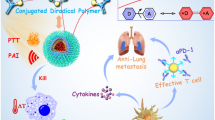Abstract
A novel methoxy-poly(ethylene glycol) modified nano-graphene oxide (NGO-mPEG) was designed and synthesized as a photosensitizer (PS) carrier for photodynamic therapy of cancer. NGO with a size below 200 nm was prepared using a modified Hummers’ method. NGO was observed by AFM to exhibit a structure with single-layer graphene oxide sheets down to a few nanometers in height. Hydrophilic mPEG conjugation of NGO (NGO-mPEG) was found to enhance solubility in cell culture media. No apparent cytotoxicity of the NGO-mPEG was observed towards MCF-7 carcinoma cell line. Zinc phthalocyanine (ZnPc), a photosensitizer for photodynamic therapy, was loaded in the NGO-PEG through π-π stacking and hydrophobic interactions, with the drug loading efficiency up to 14 wt%. Hydrophobic ZnPc was internalized in MCF-7 cells, exhibiting a pronounced phototoxicity in the cells under Xe light irradiation. The results indicate a great potential of NGO-mPEG for photodynamic therapy of cancer.
Similar content being viewed by others
References
Dolmans D, Fukumura D, Jain RK. Photodynamic therapy for cancer. Nat Rev Cancer, 2003, 3: 380–387
Plaetzer K, Krammer B, Berlanda J, Berr F, Kiesslich T. Photophysics and photochemistry of photodynamic therapy: Fundamental aspects. Laser Med Sci, 2009, 24: 259–268
Hu XH, Feng YM, Lu JQ, Allison RR, Cuenca RE, Downie GH, Sibata CH. Modeling of a type II photofrin-mediated photodynamic therapy process in a heterogeneous tissue phantom. Photochem Photobiol, 2005, 81: 1460–1468
Owens JW, Smith R, Robinson R, Robins M. Photophysical properties of porphyrins, phthalocyanines, and benzochlorins. Inorg Chim Acta, 1998, 279: 226–231
Cynthia MA, Wesley MS, Johan EVL. Current status of phthalocya nines in the photodynamic therapy of cancer. J Porphyr Phthalocya, 2001, 5: 161–169
Sibani SA, McCarron PA, Woolfson AD, Donnelly RF. Photosensitiser delivery for photodynamic therapy. Part 2: Systemic carrier platforms. Expert Opin Drug Del, 2008, 5: 1241–1254
Dougherty TJ, Kaufman JE, Goldfarb A, Weishaupt KR, Boyle D, Mittleman A. Photoradiation therapy for treatment of malignant tumors. Cancer Res, 1978, 38: 2628–2635
Zhang M, Murakami T, Ajima K, Tsuchida K, Sandanayaka ASD, Ito O, Iijima S, Yudasaka M. Fabrication of ZnPc/protein nanohorns for double photodynamic and hyperthermic cancer phototherapy. Proc Natl Acad Sci USA, 2008, 105: 14773–14778
Dhami S, Phillips D. Comparison of the photophysics of an aggregating and non-aggregating aluminium phthalocyanine system incorporated into unilamellar vesicles. J Photoch Photobio A, 1996, 100: 77–84
Konan YN, Gurny R, Allemann E. State of the art in the delivery of photosensitizers for photodynamic therapy. J Photoch Photobio B, 2002, 66: 89–106
Vrouenraets MB, Visser GWM, Snow GB, van Dongen GAMS. Basic principles, applications in oncology and improved selectivity of photodynamic therapy. Anticancer Res, 2003, 23: 505–522
van Nostrum CF. Polymeric micelles to deliver photosensitizers for photodynamic therapy. Adv Drug Deliver Rev, 2004, 56: 9–16
Derycke ASL, de Witte PAM. Liposomes for photodynamic therapy. Adv Drug Deliver Rev, 2004, 56: 17–30
Novoselov KS, Geim AK, Morozov SV, Jiang D, Zhang Y, Dubonos SV, Grigorieva IV, Firsov AA. Electric field effect in atomically thin carbon films. Science, 2004, 306: 666–669
Wang XR, Li XL, Zhang L, Yoon Y, Weber PK, Wang HL, Guo J, Dai HJ. N-Doping of graphene through electrothermal reactions with ammonia. Science, 2009, 324: 768–771
Allen MJ, Tung VC, Kaner RB. Honeycomb carbon: A review of graphene. Chem Rev, 2010, 110: 132–145
Dreyer DR, Park S, Bielawski CW, Ruoff RS. The chemistry of graphene oxide. Chem Soc Rev, 2010, 39: 228–240
Yang WR, Ratinac KR, Ringer SP, Thordarson P, Gooding JJ, Braet F. Carbon nanomaterials in biosensors: Should you use nanotubes or graphene? Angew Chem Int Edit, 2010, 49: 2114–2138
Sun XM, Liu Z, Welsher K, Robinson JT, Goodwin A, Zaric S, Dai HJ. Nano-graphene oxide for cellular imaging and drug delivery. Nano Res, 2008, 1: 203–212
Yang XY, Zhang XY, Liu ZF, Ma YF, Huang Y, Chen Y. High-efficiency loading and controlled release of doxorubicin hydrochloride on graphene oxide. J Phys Chem C, 2008, 112: 17554–17558
Zhang L, Liang JJ, Huang Y, Ma YF, Wang Y, Chen YS. Size-controlled synthesis of graphene oxide sheets on a large scale using chemical exfoliation. Carbon, 2009, 47: 3365–3368
Berger C, Song ZM, Li XB, Wu XS, Brown N, Naud C, Mayou D, Li TB, Hass J, Marchenkov AN, Conrad EH, First PN, de Heer WA. Electronic confinement and coherence in patterned epitaxial graphene. Science, 2006, 312: 1191–1196
McAllister MJ, Li JL, Adamson DH, Schniepp HC, Abdala AA, Liu J, Herrera-Alonso M, Milius DL, Car R, Prud’homme RK, Aksay IA. Single sheet functionalized graphene by oxidation and thermal expansion of graphite. Chem Mater, 2007, 19: 4396–4404
Li D, Muller MB, Gilje S, Kaner RB, Wallace GG. Processable aqueous dispersions of graphene nanosheets. Nat Nanotechnol, 2008, 3: 101–105
Qian HS, Guo HC, Ho PCL, Mahendran R, Zhang Y. Mesoporous-silica-coated up-conversion fluorescent nanoparticles for photodynamic therapy. Small, 2009, 5: 2285–2290
Author information
Authors and Affiliations
Corresponding author
Rights and permissions
About this article
Cite this article
Dong, H., Zhao, Z., Wen, H. et al. Poly(ethylene glycol) conjugated nano-graphene oxide for photodynamic therapy. Sci. China Chem. 53, 2265–2271 (2010). https://doi.org/10.1007/s11426-010-4114-9
Received:
Accepted:
Published:
Issue Date:
DOI: https://doi.org/10.1007/s11426-010-4114-9




